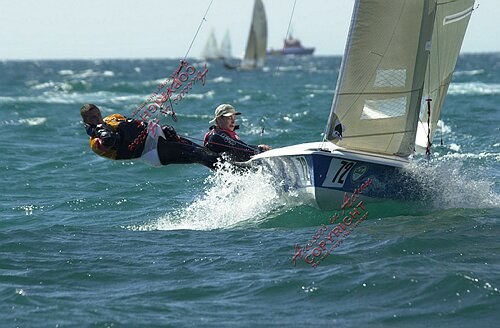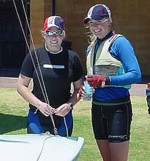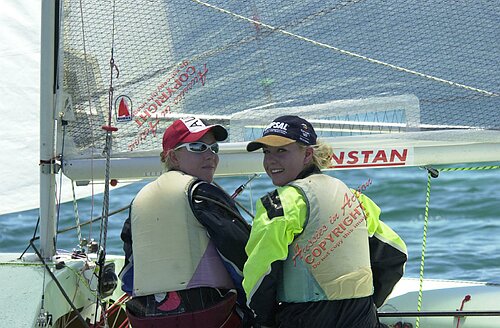Recollections of Australian
Nationals/Pre-Worlds Race 1

Saturday, 7th December 2002
Dear all:
I have received some e-mails asking for more information about the first race of the 505 Australian Nationals/pre-worlds. A report was sent to the e-mail media list and was posted on the Yachts and Yachting web site and probably other sailing web sites. However, for those of you wanting more detail...
The race started at 15:00 as the morning was spent on measurement and registration. This appears to be the time of day when the Fremantle Doctor is strongest. There is a difficult sail out of the launching area down a narrow channel inside a high rock breakwater. The wind is VERY shifty and puffy in there, and it would be very easy to capsize and damage the boat. We chose to launch early and avoid being in a crowd getting down the channel. So we were out over an hour ahead of time, sailed around, tuned the boat and then hove-to to rest. Since it was the pre-worlds and Pip and I had not sailed in a while, we were trying to "take it easy" on ourselves and our gear. It was clearly quite windy when we first got out of the harbour and I think it became windier while we waited for the fleet to come out and the race to start. I heard afterwards that there was 24 knots at the start and it built to 27-28 shortly afterwards with gusts ove r 30. The wind strengths you may have heard depend in part on what you are looking at. There is an anemometer with a digital display in the Fremantle Sailing club dinghy building where we are that apparently reads high due to wind coming up at it off the rock breakwater. There are weather buoys/stations that provide information on the web. One of these is
Rottnest island, which is some distance off the coast, and windier than where we
race. Check-out the
weather
forecast and wind graphs.
So I do not know if it was 30 knots or 40 knots or what. It was VERY windy. The shallow water and sailing inside a couple of islands means that rather than ocean swells we have a steep chop. Very hard to sail in and hard on the equipment as you get air coming over a wave and than slam down back into the water.
Pip Pearson and I thought we were OK at the start, but I noticed a distinct increase in wind speed part way up the first beat. At that point we had run out of depower strings (we were racing with Pip's small centerboard, and would have been in worse shape with a full-sized board) and it became quite a bit harder for us to sail to windward as we raised the board to depower and with the main mostly flogging the boat was developing lee helm. At several points we discussed whether we wished to continue the race, and before we rounded the windward mark we agreed that we would take a "checkpoint" before the leeward mark and decide it we would continue to sail in at that point. This was a good race to have a tall heavy crew in!
Pip's 505 has a Goldspar mast. Compared to the US Proctor D setup, the spreaders are longer and swept aft. With lots of rig tension the mast seemed to be reasonably well supported. I believe we cleated the ram uphaul before hoisting the kite, something that I would automatically have done on one of my Proctor D-equipped 505s, but which seems to be rather less of an issue with the Goldspar (most Aussie's have their rams lower on the mast, nearly at deck level, so they do not support the mast as high as the US setup does. From my angle the mast looked OK, but then we never buried the bow. Going down the run we saw two boats with broken rigs but did not know how they did it and assumed capsizes. Most teams did bear-away sets and raced towards the shore on starboard at high speed. Several of the teams in front of us capsized so we were actually in pretty good shape in the race, perhaps inside the top 15. We did not do the classic wi re run, but pulled the pole back slightly and sailed a little lower, maybe not as fast as the full on wire run, but easier. We were still planing fast the whole time, but might not have passed as many waves as those who sailed higher. Our low aspect ratio kickup rudder never stalled, and Pip's rudder head to transom fittings attachment is VERY strong, so we have not had any rudder problems.
We jibed with the kite up without problem, sailed to the leeward mark and decided to retire as we had discussed. We sailed in without further problem, though the sail up the channel inside the breakwater was probably some of the most difficult sailing I have ever done (outside was easy by comparison!). Even sailing lower than the pole-on-the-forestay-go-as-fast-as-you-can group, we were not far off laying the jibe mark (we were on the run, but the jibe mark was already in place). Howard and Mike flew their kite on the reaches, so broadening the reaches ten degrees seems to allow teams to carry the LLS OK, and the feel of the boat is similar to the old higher reach with the short luff spinnaker, except you are going faster.
While we sat in the dinghy park a slow but steady stream of boats sailed in or were towed in. The final count may have been something like 18 masts broken (I have heard several different numbers). I believe the majority broke on capsizes, but several teams broke masts when the kite filled after the hoist, and the bow buried. Krister Bergstrom was watching the race from one of the powerboats as the German container was still stuck in customs/quarantine, and apparently saw three rigs go when the kite filled and the bow buried. Tom Bojland reported that the broken masts were Proctor Ds/Cumulus and Goldspars but no Superspar M2s broke (I know of one Superspar that was on the water being used by Simon Payne/Bill Masterman, but none of the Germans were racing as their container had not been released). I have no idea how many Superspar M2s were out there, so cannot comment on which masts were holding up better.
I think the more pre-bent rigs are p robably better at supporting the upper mast. While I have not taken photographs or notes, there are all sorts of upper spreader, upper shroud and spreader extension systems being used. I do not know if any of those broke, or if all the breakages were masts with no additional support. There were broken rudders, broken rudder fittings, rudders coming off and more. A number of boats were towed in. It occurs to me that the high aspect ratio rudders probably load up the rudder fittings more than the older blades did.
In the end, something like 21 boats finished the race. Some or most of them sailed an extra windward/leeward as the leeward finish line (many had not seen the course flag which was apparently hoisted late) was well to leeward of the leeward mark and you could not see much in the conditions. Since they could not see the finish line Howard Hamlin/Mike Martin, who were leading by this point, turned back upwind looking for a windward finish and most of the remaining fleet followed. Some teams ended up crossing the line as they sailed back to the club and noticed there was a finish line past the leeward mark!
 |
Perhaps the best story of the race is that two local young women got around the course, sailed the proper course, pinched their way upwind and did not fly the kite downwind, but did not capsize.
I believe the skipper is 16 or 17 and the crew 19.
They finished 6th by not doing the extra lap!
|


My view is that it is not so much the wind that was a problem, but the shallow water and very steep chop made for very challenging conditions. In deeper water and ocean swells the sailing would have been easier and I think we would have had far fewer breakdowns and most probably fewer retirements.
I believe that between backup masts and new masts (the Australians had some and Ian Pinnell brought some) every team was able to replace the broken rigs. However Ian told me he only had two Ds and no Cumulus masts left
I asked the 505world list for opinions on the Long Luff Spinnaker after using it for a year, shortly before I flew to Fremantle for the pre-worlds. I received 25-50 e-mails in response, only one of which expressed some concerns about the LLS, but was neither in favour of it or opposed to it. All other responses I received were in favour of it.
In discussions here in the dinghy park I believe everyone I have spoken with is in favour of it, with many being very enthusiastic about it. While those who attend world championships are not representative of the club-and-local racers who do not, it is interesting to see how many people love the LLS, even after such an extreme day or racing with some many breakdowns.
Today is the measurement and registration day between the re-worlds and worlds. The German and US East Coast boats that were in containers not released until after the day of the first race, are being measurement checked. Competitors are enjoying Fremantle, and getting ready for the first day or Worlds racing tomorrow.
Cheers,
Alexander Meller
President, International 505 Class Yacht Racing Association
|
 International
International


